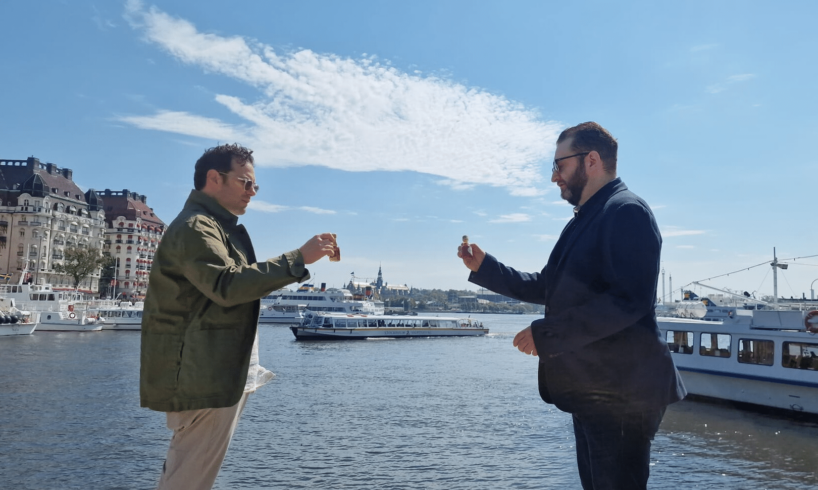
In Sweden — a country more associated with ABBA than Abraham — Yiddish has quietly returned to public life.
Once a fading echo of Eastern Europe, it’s now one of Sweden’s officially recognized minority languages, taught in universities, performed on stages, and championed by cultural organizations determined to keep it alive. It’s even the subject of a new documentary that asks how Jewish culture endures — and evolves — in the most unexpected places.
In “Swedishkayt: YidLife Crisis in Stockholm,” Montreal-based comedians Jamie Elman and Eli Batalion, the duo behind the Yiddish comedy project YidLife Crisis, travel to Sweden to uncover the country’s surprisingly rich Jewish story. What they find spans centuries: from the arrival of the first officially permitted Jews in 1774 to today’s community of roughly 20,000, navigating what it means to be Jewish in a nation better known for neutrality than for nosh.
“Swedishkayt” explores Sweden’s Yiddish boom
Elman and Batalion were first introduced to Sweden’s Yiddish scene in the most unexpected way. Nearly a decade ago, after a live show in the United Kingdom, they were approached by a Yiddish professor from Lund University who told them that their Yiddish web series — created in 2014 to both celebrate and gently satirize Jewish culture through a modern lens — was being used as teaching material in his classroom.
“That little seed was planted of total insanity, that there were, first of all, Jews in Sweden. Second of all, that Yiddish was being taught there,” Batalion told Unpacked.
Intrigued, the duo began learning more about Jewish life in Sweden and were eventually invited to perform in Stockholm. There, they discovered a complex and surprising history: Yiddish had arrived with Ashkenazi immigrants in the 18th century but wasn’t formally recognized by the Swedish state until 1999. That year, Parliament passed a bill granting official minority-language status to five languages — Finnish, Meänkieli, Romani Chib, Sámi, and Yiddish.
Eli Batalion and Jamie Elman in “Swedishkayt” (courtesy)
Why did Sweden include Yiddish? The country’s criteria for official minority-language status require that a language have a longstanding presence in Sweden and that it be part of the cultural heritage of a distinct minority group of European origin.
Once the status was granted, several concrete rights and supports followed:
The law established a societal responsibility to protect and promote Yiddish, via funding for cultural organizations, educational programs, and media.
Children of parents belonging to a national minority have the right to study the minority language in school, meaning Swedish children from Jewish families may learn Yiddish as part of their heritage.
Although Yiddish does not have the same territorial language rights (such as the ability to use it in all government correspondence) as Finnish or Sámi in certain municipalities, its protection still marks it as a “living” language in Sweden’s official policy comes in Yiddish — signalling a recognition that Jewish culture is part of Sweden’s national story.
Cultural output in Yiddish has gained support: children’s books, radio programmes, television shows, and even university‐level Yiddish studies are now part of the ecosystem in Sweden.
Today, the language’s presence in Swedish life is subtle but remarkably diverse. Classic novels and contemporary favorites like “Harry Potter” have been translated into Yiddish through Swedish publishers. Government websites offer information on everything from public safety to sexual health in Yiddish. There are Yiddish theater troupes, choirs, and even a small klezmer music scene. For Elman and Batalion, this unexpected blend of Nordic order and Jewish expression became irresistible material, proof that Yiddish can find a home anywhere, even under the northern lights.
Understanding the mosaic of Jewish life in Sweden
In “Swedishkayt,” Batalion and Elman meet a cross-section of Sweden’s Jewish community that’s as eclectic as it is surprising. They talk with rabbis and historians preserving centuries of tradition, young Jewish artists and educators reimagining what Swedish Jewish identity can look like, and even those who helped make Yiddish a protected minority language. Along the way, they visit Stockholm’s Great Synagogue, chat with locals about everything from antisemitism to assimilation, and discover a community that’s both deeply rooted and refreshingly forward-looking: one that finds meaning not in numbers, but in continuity, creativity, and humor.
The Great Synagogue in Stockholm (courtesy)
What struck the pair most was how Swedish Jews felt both familiar and distinct. Despite the cultural and geographic distance, there was an immediate sense of kinship — what they describe as a heimish, deeply welcoming atmosphere.
“On a certain level, I think what surprised us most is that despite how different they are, their Jewishness, their Yiddishkeit, is very obvious to us, and universal,” Elman told Unpacked.
The film also brushes up against Sweden’s famous Laws of Jante — an unwritten social code that prizes humility and discourages standing out — a sharp contrast to the expressive, outspoken character of Jewish life the comedians know from North America.
“The laws of Jante have to do with not taking up too much space in public and not being too loud. That definitely plays into them as Jews on a certain level,” Elman added. “We’re the opposite of that.”
YidLife Crisis is exploring the Jewish world globally
Over the past decade, Batalion and Elman have taken YidLife Crisis on the road, exploring Jewish food, humor, and identity in cities across the globe — from Montreal and New York City to London, Detroit, Toronto, Houston, New York City, and Kraków.
Each stop offered a different flavor of Jewish life, but Stockholm stood out. Unlike hubs such as Montreal or New York, where Judaism is woven into the urban fabric, Sweden’s Jewish presence is small and understated, yet unmistakably proud.
“It was its own unique Swedish snowflake. There were certain particulars that were only going to be for Sweden,” Batalion said. “But there were certain common similarities, as we joked in the film, the only difference between us and the Swedish Jews is that when fleeing the pogroms, we decided to go all the way to North America because we had more frequent flyer points. We came from the same place, and so our cultures were identical before we got there. So some traditions are different, some are the same as we’ve experienced throughout the diaspora.”
One of the recurring themes in “Swedishkayt,” unlike the other YidLife Crisis videos, is just how difficult it can be to live a fully Jewish life in Sweden — starting with something as simple as finding kosher food. Sweden’s strict animal welfare laws prohibit kosher slaughter, meaning that all kosher meat has to be imported, often from Denmark or farther abroad. The result is that even basic staples — from chicken to brisket — are expensive, limited, or simply unavailable outside major cities like Stockholm. For observant Jews, keeping kosher can feel like an act of logistical heroism; for others, it’s a reminder of how cultural and religious life in Sweden often exists in quiet tension with the country’s broader secular ideals.
YidLife Crisis meets with Rabbi Mattias Amster, Stockholm’s first Swedish-born rabbi (courtesy)
How young Jews are bringing Yiddish back
Across the Jewish world, younger generations are finding new meaning in Yiddish. What was once seen as the language of their grandparents has become a bridge to identity, memory, and creativity. College courses, TikTok clips, podcasts, and new translations have all helped Yiddish re-enter the cultural conversation — not as nostalgia, but as something defiantly alive.
For many Millennials and Gen Z Jews, learning Yiddish isn’t about fluency so much as connection. Many see it as an effort to reclaim the dying language from becoming obsolete, and others hope to gain cultural connection from the language largely extinguished as European Jewry was killed in the Holocaust.
“I think there’s a certain craving for people, even though the Yiddish has a spoken language, a living language, was all but wiped out in the Holocaust, there’s still an understanding, a recognition, in the 21st Century that that that Yiddish language and culture, comedy, history, literature, theater is is really the story of Ashkenazi Jews from the last 1000 years,” Elman said.
Swedishkayt poster
Elman first sensed that resurgence when YidLife Crisis took off more than a decade ago: “It was clear that there was a sort of craving to reconnect to our past, our culture, our grandparents, our ancestors. The internet era has allowed a lot of the sort of treasure trove of Yiddish to sort of be rediscovered by current generations.”
As Yiddish enjoys a renewed burst of cultural energy, debates persist over what role it should play within Jewish life. Many see its revival as an act of preservation — honoring a language that once defined a millennium of Jewish Europe. Others, however, use Yiddish as a counter-identity, one that distances itself from Hebrew and the modern State of Israel.
For Elman and Batalion, that divide misses the point. Having learned both Yiddish and Hebrew side by side in their Jewish high school in Montreal, they see the languages as complementary, not competitive. Through their comedy and documentary work, they hope to bridge divisions and remind audiences of the shared richness of Jewish expression.
“Our goal has been to use comedy as a Trojan horse of bridge-building within and beyond the Jewish community. And so we’ve never tried to be political. In fact, part of our brand is to find the comedy in debate, and that’s what you see in our characters,” Batalion said. “Our hope is that we represent the nuance of what the average Jew is thinking.”
At its heart, “Swedishkayt” isn’t just about Sweden or even Yiddish; it’s about the persistence of Jewish life in all its forms. Through humor and curiosity, Elman and Batalion show how Jewish identity keeps reinventing itself, whether in Montreal delis or Stockholm synagogues. Their journey is less a travelogue than a reminder: Jewish culture has never belonged to one place, one language, or one generation. Wherever it lands, even in the most unlikely corners of Scandinavia, it finds a way to laugh, adapt, and live on.
“Swedishkayt: YidLife Crisis in Stockholm” will be screened with a comedy show and live music at the Philadelphia Jewish Film Festival on October 30. YidLife Crisis will also present the documentary, in addition to live shows, in Washington, D.C., Baltimore, Toronto, Halifax, and Charlotte, as well as screenings at film festivals worldwide.





